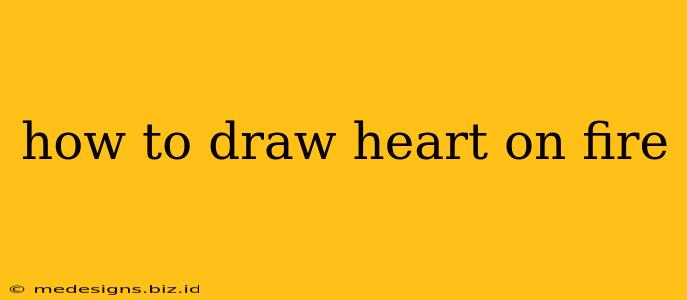Want to learn how to draw a heart engulfed in flames? This guide will walk you through several techniques, from simple sketches to more detailed, fiery masterpieces. Whether you're a complete beginner picking up a pencil for the first time, or you're looking to refine your existing skills, this tutorial is for you! We'll cover different styles and levels of complexity to suit your skill level and desired outcome.
Understanding the Fundamentals: Heart Shapes and Flame Dynamics
Before diving into the fiery heart, let's master the basics.
Drawing a Perfect Heart:
Start with a simple, symmetrical heart. You can use the classic upside-down "V" shape connected to a curved line at the bottom. Practice drawing several hearts until you're comfortable with the shape. Experiment with different widths and heights to find your preferred style.
Observing Fire Dynamics:
Observe real flames – candle flames, campfires, even a fireplace. Notice the shape, movement, and the varying intensity of the light and shadow within the flames. Flames are rarely symmetrical; they are dynamic and unpredictable, with flickers and tendrils dancing upwards. Understanding this irregularity is key to drawing realistic fire.
Method 1: The Simple Fiery Heart
This method is perfect for beginners. We'll combine a simple heart shape with stylized flames.
- Sketch the Heart: Draw a basic heart shape lightly with a pencil.
- Add the Flames: Draw simple, pointed flame shapes around the heart's outline. Don't worry about perfect symmetry; aim for a dynamic, slightly chaotic look.
- Refine the Flames: Add smaller flames within the larger ones, creating depth and variation.
- Add Shading: Use shading to create the illusion of light and shadow within the flames. Darker areas represent depth, while lighter areas indicate where the fire is brighter.
- Final Touches: Erase any unnecessary pencil lines and add any final details. You can add subtle highlights for extra impact.
Method 2: The Detailed Fiery Heart
This method is for those who want to create a more realistic and detailed fiery heart.
- Detailed Heart Sketch: Draw a well-defined heart, paying attention to curves and proportions.
- Flame Structure: Instead of simple points, draw individual flames with subtle curves and variations in thickness. Think about how the flames would wrap around the heart's shape.
- Layering Flames: Create layers of flames, with some flames extending further than others, creating depth and a sense of movement.
- Advanced Shading: Use a range of shading techniques, such as hatching and cross-hatching, to create subtle variations in tone and texture within the flames.
- Adding Embers: Include glowing embers at the heart's base for added realism.
Method 3: The Abstract Fiery Heart
This method allows for more creative freedom.
- Abstract Heart Shape: Don't limit yourself to a traditional heart shape. Experiment with more abstract and stylized heart forms.
- Fluid Flame Movements: Instead of pointed flames, use flowing, brush-like strokes to depict the fire.
- Color Exploration: This style lends itself well to the use of vibrant colors. Experiment with different shades of red, orange, yellow, and even purple to create a striking visual effect.
- Texture and Pattern: Add texture to the flames using techniques like stippling or scribbling to create a more expressive and less defined look.
Tips for Success
- Practice Regularly: The key to improving your drawing skills is consistent practice. Draw hearts and flames repeatedly to build muscle memory and refine your techniques.
- Use Reference Images: Look at photos and videos of real flames to observe their behavior and learn from their dynamic shapes.
- Experiment with Different Media: Try different drawing tools, such as charcoal, pastels, or colored pencils, to achieve various effects.
- Don't Be Afraid to Make Mistakes: Mistakes are a part of the learning process. Embrace them, learn from them, and keep practicing.
By following these steps and techniques, you'll be well on your way to drawing stunning hearts on fire! Remember to have fun and let your creativity flow. With practice, you'll develop your own unique style and create truly breathtaking artwork.
